
Saludos amigos de @foodiesbeehive.
Como dicen, la magia entra por la boca y en navidad parte de su magia se encuentra en los platos que se preparan en estas fechas y que por lo general los compartimos con amigos y familiares.
Cada país tiene sus tradiciones culinarias que abarcan platos salados, postres y bebidas. En Venezuela, mi país contamos con una gran variedad de estos platos, pero sin dudas, el que más destaca es nuestra tradicional hallaca.
La hallaca es una preparación llena de sabores y colorido, con tres componentes que la definen: el guiso, la masa y las hojas de plátano asadas que la envuelve, de ella se han derivado otros productos como son los bollos navideños y la polenta criolla.
En días pasados compartí en la comunidad la preparación del guiso navideño, acompañado con yuca, hoy les traigo los bollos.
Cabe destacar que el guiso es exquisito, sin embargo, es en la unión de sus tres componentes que se siente ese sabor navideño en plenitud, pues el sabor salado-dulzón de la masa de maíz resalta el gusto del guiso, mientras que el aroma de la hoja de plátano asado, es un olor que entra en la gama de “olor navideño” que impregna los hogares y define al plato como único. Sin más alabanzas vamos como con los ingredientes y su preparación.
Greetings friends of @foodiesbeehive.
As they say, magic enters through the mouth and at Christmas time part of its magic is found in the dishes that are prepared on these dates and that we usually share with friends and family.
Each country has its culinary traditions that include savory dishes, desserts and drinks. In Venezuela, my country, we have a great variety of these dishes, but without a doubt, the one that stands out the most is our traditional hallaca.
The hallaca is a preparation full of flavors and color, with three components that define it: the stew, the dough and the roasted banana leaves that surround it, from which other products have been derived such as Christmas buns and polenta criolla.
In the past days I shared in the community the preparation of Christmas stew, accompanied with yucca, today I bring you the buns.
It should be noted that the stew is exquisite, however, it is in the union of its three components that you feel that Christmas flavor in fullness, as the salty-sweet flavor of the corn dough highlights the taste of the stew while the aroma of the roasted banana leaf, is a smell that enters the range of "Christmas smell" that permeates homes and defines the dish as unique. Without further praise, let's go with the ingredients and their preparation.
Ingredientes/Ingredients (25 raciones)
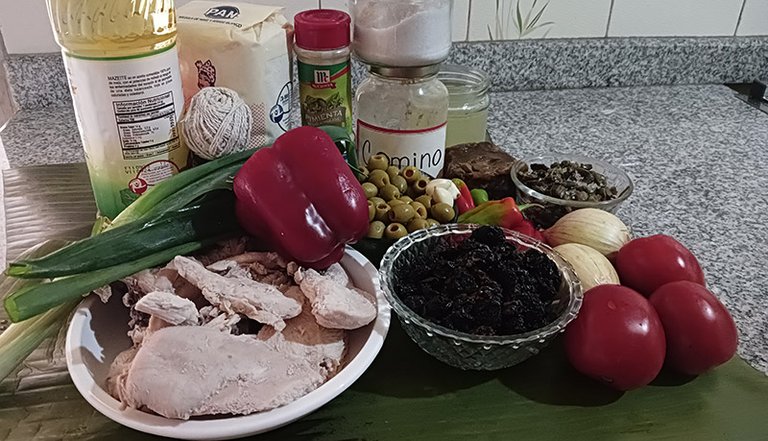
1 ½ de pechuga de pollo con hueso
2 tazas de caldo de pollo
2 cebollas medianas
½ pimentón
5 ajíes dulces
1 tallo grande de cebollín
1 tallo de ajoporro
4 tomates maduros
5 dientes de ajo
3 cucharadas de aceite
1 kg de harina de maíz
4 cucharadas de papelón espeso
½ taza de alcaparra
1 taza de aceitunas rellenas de pimentón
1 ½ taza de pasitas
1 cucharadita de comino
10 guayabitas (opcional)
Sal y pimienta al gusto
1 litro de agua
1 kg de hojas de plátano asadas
Pabilo
1 ½ bone-in chicken breasts
2 cups chicken broth
2 medium onions
½ bell pepper
5 sweet peppers
1 large scallion stalk
1 stalk of ajoporro
4 ripe tomatoes
5 cloves of garlic
3 tablespoons of oil
1 kg corn flour
4 tablespoons of thick papelón
½ cup capers
1 cup of olives stuffed with paprika
1 ½ cup raisins
1 teaspoon cumin
10 guayabitas (optional)
Salt and pepper to taste
1 liter of water
1 kg of roasted plantain leaves
Wick
Procedimiento/Procedure
1.- Limpiamos y fileteamos el pollo. Lo llevamos al fuego en una en olla con un litro de agua, dos dientes de ajo triturado, 1 cucharadita de sal y la rama de ajoporro. Dejamos cocinar hasta que esté blando y reduzca a dos tazas. Este será el caldo de pollo. Reservamos.
2.- En una olla pequeña colocamos taza y media de agua, incorporamos los 200grs de papelón, llevamos a fuego lento, dejamos que se disuelva el papelón y que quede espeso. Reservamos.
3.- Lavamos y cortamos en trozos pequeños la cebolla, los tres dientes de ajos restante, pimentón, ajíes, cebollín. Colocamos a fuego alto un caldero, agregamos el aceite y comenzamos a sofreír
1.- Clean and fillet the chicken. We take it to the fire in a pot with a liter of water, two cloves of crushed garlic, 1 teaspoon of salt and the branch of ajoporro. Let it cook until it is soft and reduced to two cups. This will be the chicken broth. Set aside.
2.- In a small saucepan place a cup and a half of water, add 200grs of paprika, bring to a low heat, let the paprika dissolve and let it thicken. Set aside.
3.- Wash and cut into small pieces the onion, the remaining three cloves of garlic, paprika, chili peppers and spring onion. Place a pot over high heat, add the oil and start frying.
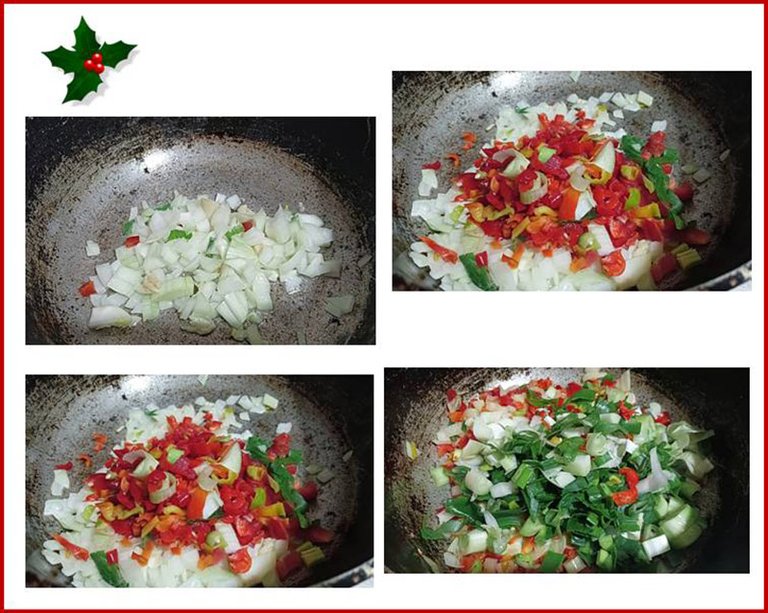
4.- Una vez sofrito los aliños agregamos los tomates licuados (Licuar con el mínimo de agua posible), cuando el tomate se sofría agregamos las dos tazas de caldo de pollo, ajustamos el toque de sal, (recordando que incorporaremos otros ingredientes salados), comino y pimienta. Cuando hierva, tapamos y dejamos cocinar a fuego bajo, entre 10 y 15 min.
4.- Once the seasonings are sautéed, add the blended tomatoes (blend with as little water as possible), when the tomatoes are sautéed, add the two cups of chicken broth, adjust the touch of salt (remembering that we will add other salty ingredients), cumin and pepper. When it boils, cover and let it cook over low heat for 10 to 15 minutes.

5.- Trascurrido el tiempo, incorporamos el pollo desmechado, grueso y las alcaparras picadas, dejamos otros 5 minutos e incorporamos las aceitunas y las pasitas, ajustamos sal, comino y pimienta, dejamos 5 min más y apagamos. Ya tenemos el guiso listo. Dejamos enfriar.
5.- After the time has elapsed, we incorporate the chicken, thickly shredded, and the chopped capers, we leave another 5 minutes and we incorporate the olives and the raisins, we adjust salt, cumin and pepper, we leave 5 more minutes and we turn off. The stew is ready. Let it cool down.
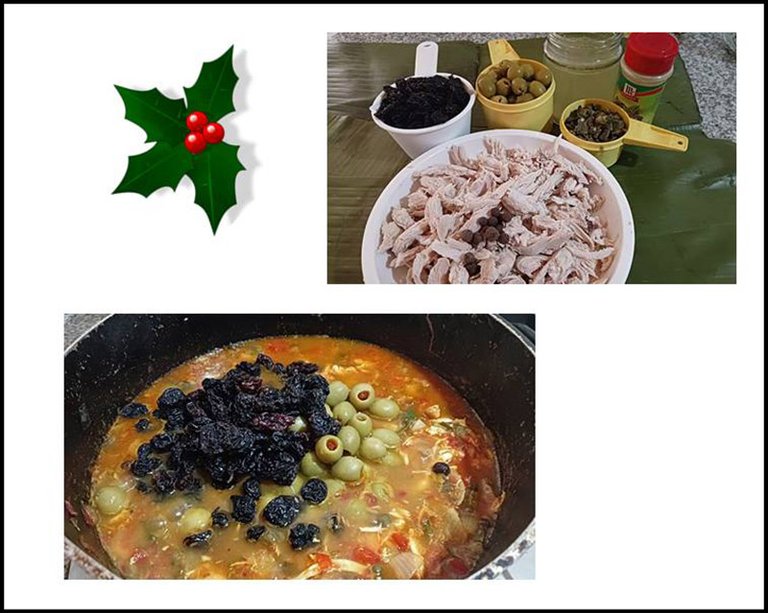
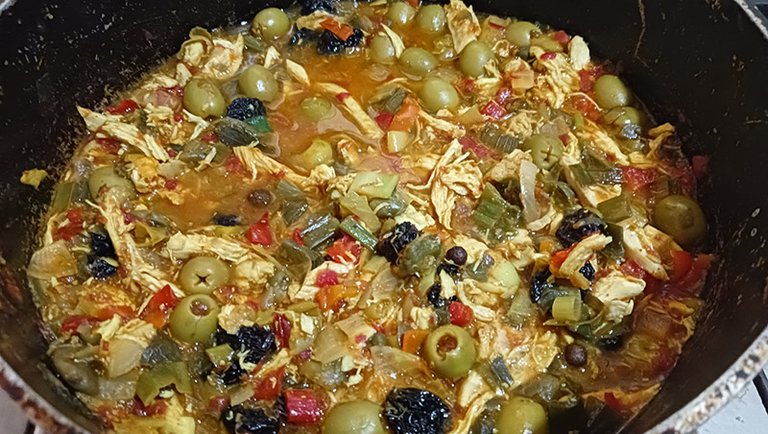
6.- Mientras el guiso enfría cortamos y lavamos las hojas de plátano, podemos cortarlas en trozos de 25 cm de ancho aproximadamente.
7.- Una vez que el guiso está a temperatura ambiente, procedemos a preparar la masa. En un envase grande agregamos 2 tazas de agua y 2 tazas de harina (½ Kg) de manera gradual para que no haga grumos, amasamos un poco e incorporamos el guiso, agregamos otra taza de agua, las cuatro cucharadas de papelón líquido y el ½ kg de harina restante. Amasamos, podemos agregar más agua de ser necesario, la idea es que nos quede una masa suave y blanda.
Mientras amasamos ajustamos el punto de sal que es conveniente dejarla un poquito alta de lo normal.
6.- While the stew cools we can cut and wash the plantain leaves, we can cut them in pieces of 25 cm wide approximately.
7.- Once the stew is at room temperature, we proceed to prepare the dough. In a large container add 2 cups of water and 2 cups of flour (½ Kg) gradually so that it does not make lumps, knead a little and incorporate the stew, add another cup of water, the four tablespoons of liquid papelón and the remaining ½ kg of flour. We knead, we can add more water if necessary, the idea is to have a smooth and soft dough.
While kneading we adjust the salt level, it is convenient to leave it a little higher than normal
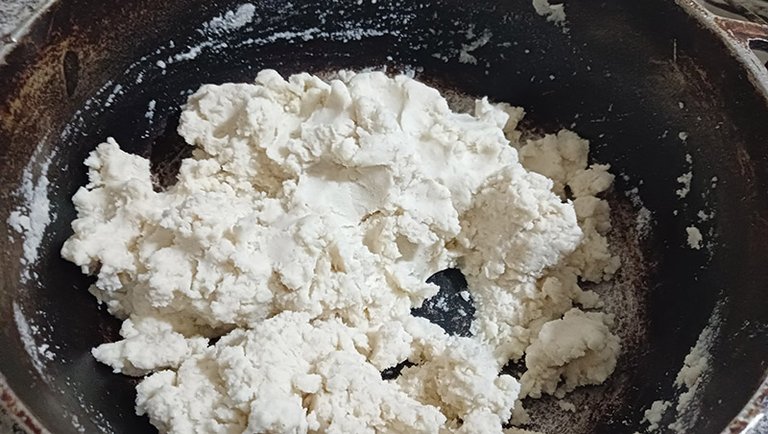
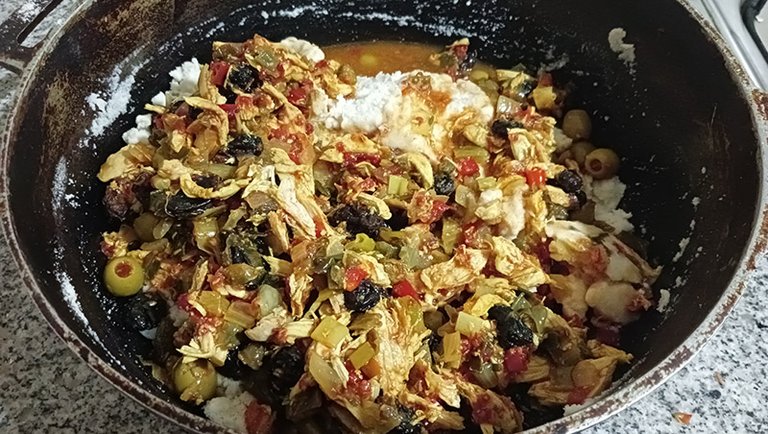
8.- Una vez que tenemos la masa lista y las hojas limpias, pasamos a armar los bollos. Sobre la hoja colocamos una porción de masa preparada, aproximadamente unos 100 grs, si queremos unos bollos pequeños y 150 grs si los deseamos medianos.
8.- Once the dough is ready and the leaves are clean, we start to assemble the buns. On the leaf we place a portion of prepared dough, approximately 100 grams if we want small buns and 150 grams if we want medium ones.
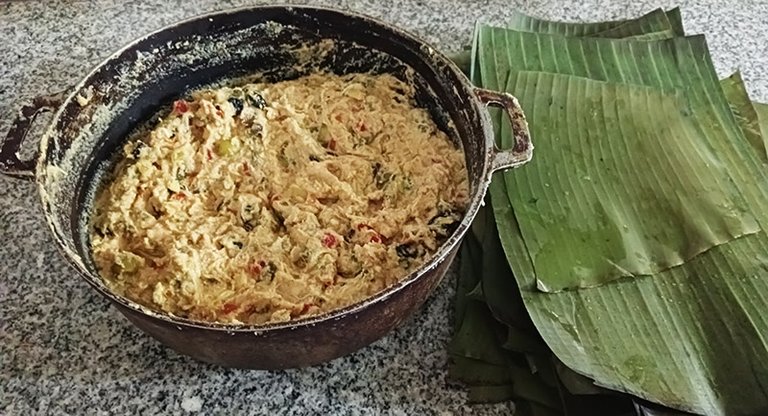
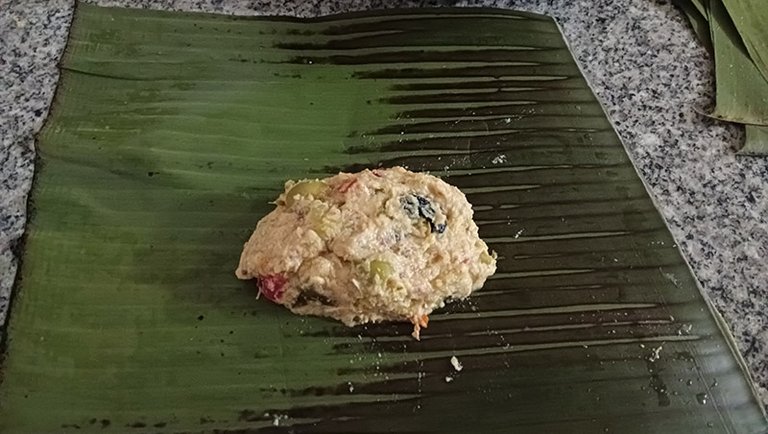
9.- Envolvemos y doblamos los bordes hacia dentro, dándole una forma rectangular y procedemos a amarrarlos con el pabilo.
9.- Wrap and fold the edges inward, giving it a rectangular shape and proceed to tie them with the wick.

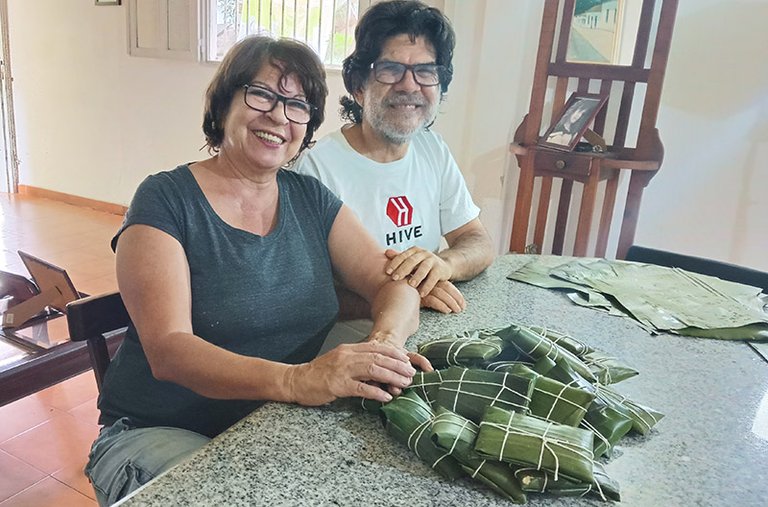
10.- Cuando tenemos todos los bollos listos, los llevamos a sancochar, para lo cual hemos puesto a hervir agua en una olla grande, llena hasta la mitad. Introducimos los bollos cuando el agua este hirviendo, tapamos con hojas y dejamos que hierva nuevamente, al hacerlo bajamos a fuego medio y dejamos hervir por 40 minutos.
10.- When we have all the buns ready, we take them to parboil, for which we have put water to boil in a large pot, half full. We introduce the buns when the water is boiling, we cover with leaves and we let it boil again, when we do it we lower to medium heat and let it boil for 40 minutes.
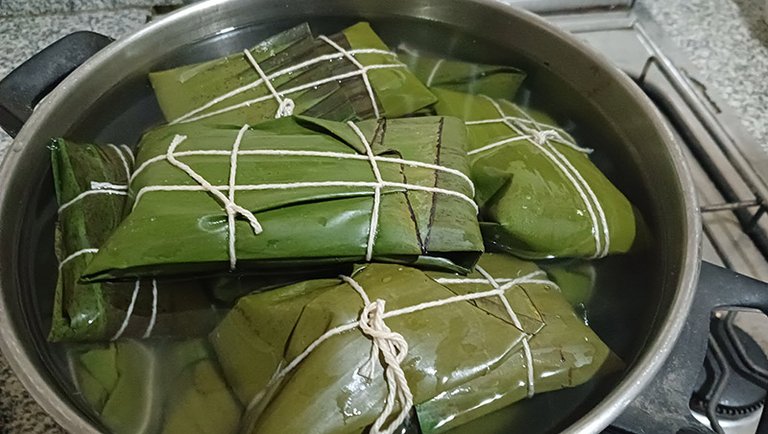
11.- Transcurrido este tiempo, retiramos del fuego, botamos el agua de la olla y dejamos reposar.
12.- ¡Listo!, cortamos el pabilo, abrimos y tenemos nuestros exquisitos bollos para disfrutar.
11.- Once this time has elapsed, remove from the heat, pour the water out of the pot and let it rest.
12.- Ready, cut the wick, open and we have our delicious buns to enjoy.
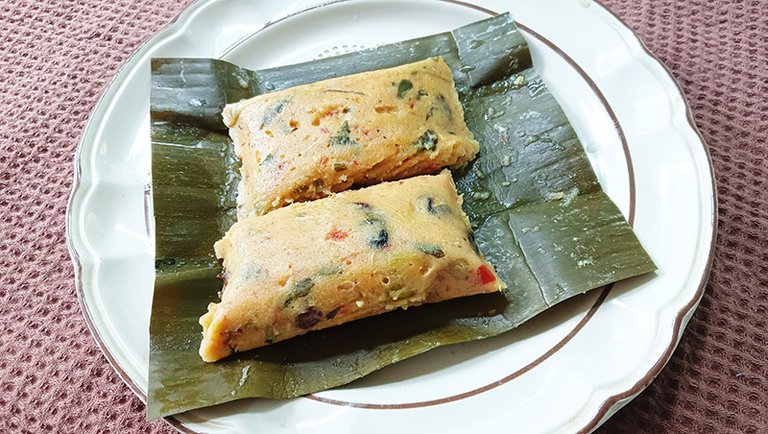

Translated with www.DeepL.com/Translator (free version)
Fuente de imágenes: Archivo personal



MIS REDES SOCIALES





Be Entrepreneur




